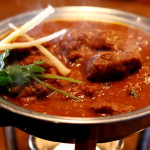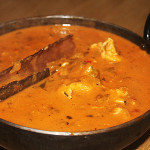“I’d rather be a little weird than all boring” – Rebecca McKinsey
As I was buying an Indian takeaway for me and my boy, it suddenly occurred to me that beyond the super-luxury gourmet end of the market, almost every Indian restaurant and takeaway in the country offers pretty much the same dishes, with a few variations. You want a lamb rogan josh or a chicken korma?
You can bet your bottom dollar they will be there on every menu anywhere in the UK – restaurant style rather than that found in Indian homes. In fact, most of the restaurants we label as “Indian” are actually Bangladeshi or Pakistani, so let’s just say food mostly originating in inspiration from the Indian subcontinent. Don’t forget that the British favourite chicken tikka masala and balti (‘bucket’ in Hindi, Bengali and Urdu) most probably originated in restaurant kitchens over here.
Same with Chinese: show me a takeaway that isn’t serving BBQ ribs, prawn sesame toasts, sweet & sour pork, chow mein and dozens more dishes that are very familiar with the public and certainly in the case of the starters often highly commoditised (ie. straight from wholesalers into the freezer, thence to the deep fryer and the plate.)
Multiply that by all the burger joints, fried chicken shops, pizza parlours, chippies, rainbow restaurants of every origin and you’ll see that while each may have their own marginally unique take in order to differentiate them from the local competitors, broadly speaking their menus are identikit and entirely predictable wherever you go.
The most obvious rationale is that the vast majority of people buy and eat what is familiar to them, or to which they develop a love in the course of a lifetime. Trends change so while in my youth Chinese and Indian takeaways selling anglicised versions of native classics boomed from a very low base, so the fragmentation of food origins has continued. The trend for cheap sushi meant that Japanese gained a foothold in the lunch market, while still not widely available in takeaways, but the pace of change means that variants are constantly arriving to alter subtly the familiar dishes without anything too far out into the unknown.
So there is a distribution of punters for exotic foods out there: those who stick rigidly to what they know and never deviate from that, and others who are always trying to find something different and new. Certainly I am in the latter camp, and would sooner try a new dish in a familiar restaurant, or a different restaurant in order to sample and review – but then I am a self-acknowledged foodie, where to many food is more a ritual and a refuelling stop than a cause of constant and exhaustive interrogation.
Best of all, I’d go for restaurants that change the menu constantly according to what is good and fresh and local, but that’s not going to happen in Chinese and Indian land, precisely because so many of the clientele found a taste for one or two dishes and stuck in the rut, their adventuring over for one lifetime. We are creatures of habit, so says this article.
It’s such a shame, since it means the menus might be stuck in a time warp for generations, until there is a change of management or the world has gradually moved on with a generational shift, but for the purposes of this blog I wonder precisely why people become so deeply wedded to repeating the same dinner time and again, just as they repeat the same working day and the same family rituals throughout their lives – until something prompts them to make a step-change, maybe gives them the curiosity to try something new and develop new tastes – and restaurants, by and large, are going to stick with a successful formula that reflects the tastes of their consumers.
Granted that we’ve become much more cosmopolitan with the advent of affordable global travel, so gone are they days when Brits would fly over to Benidorm in order to eat fish and chips and drink Watney’s Red Barrel. Another instance might be that you are with a new partner you trust and who has different tastes, thus trying what they enjoy is an act of faith – but even then I’ve come across people who stick rigidly to the same formula because they “don’t like” things they haven’t actually tried for reasons that probably go back to childhood.
I was exchanging messages with a friend recently. They mentioned that they did not like sweet peppers. Asked why, they became defensive and self-righteous, such that it was not my place to ask why, just to be told that they did not like red peppers! But faddy eating does not really explain the phenomenon of why people choose to apply such minimal variation in their regular dining habits, among many other such behaviours? A bad experience would clearly direct us to rein in our temptation to go for something different, but here’s another thought:
When do people buy most takeaways, and probably eat out? It could be any day of the week that we find we can’t be bothered much to cook, but for me it’s often Friday after a hard week at work, a journey home and sometimes collecting my son. When you’re tired you can’t make decisions or go through a menu in which there are 150 different options. You go for the path of least resistance, since that is dependable. It’s not that you don’t or wouldn’t try something different, but you hone in on an easy dish that can be ordered and consumed without much thought – in other words, back to the habit story.
In my case last Friday I did go for something different at the local Indian, though my lad did invite me to choose for him because he couldn’t be bothered to select dishes after a hot and tiring day in London. When I feel exhausted it’s not unknown for me to select a beef satay dish at one of the local Chinese takeaways.
This is a curious dish, nothing like authentic satay (which is a dish of skewered meat, grilled and served with a peanut sauce) , just as “curry” at a Chinese takeaway bears no relation whatever to the freshly spiced dishes you find at your local Indian. This satay is vaguely spicy but the sauce has an appealing smoky quality that I can’t quite repeat at home. It is evidently from a packet, since it reminds me strongly of the same dish found at the local Chinese fish & chip shop in Wilmslow when I was a teenager (and which is still there, decades later!)
It’s not that there is anything particularly great about the sauce but, particularly with its memory connection back to my youth, it is by definition a form of comfort food – and therein lies the answer!









